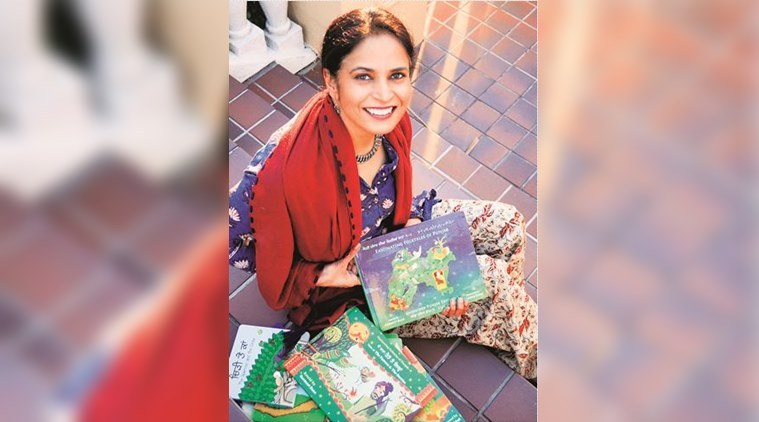Syllables that Bind
The project ‘Folktales of Punjab’ is publishing story books for children in Shahmukhi and Gurmukhi — Punjabi’s two scripts — to bridge the gap created by the Partition

Gurmeet Kaur with the children of Khalsa Orphanage.
ALONG with the geographical divide which tore it into Lehenda Punjab (West Punjab) and Chadhda Punjab (East Punjab), another blow for the undivided Punjab during the Partition was the ‘division’ of its mother tongue – Punjabi.
Seven decades after the divide, the two scripts of the language — Gurmukhi and Shahmukhi — stand as two separated sisters, oblivious of each other’s existence and given convenient tags of ‘Indian Punjabi’ (Gurmukhi) and ‘Pakistani Punjabi’ (Shahmukhi). Written in Nastaliq script, which is used to write Arabic and Persian, Shahmukhi Punjabi is even mistaken as Urdu and most people on the Indian side of Punjab are unaware of this second script, which is used to write Punjabi, other than Gurmukhi. Even in Pakistan, Shahmukhi Punjabi is facing an existential crisis.
An effort to bridge the gap between Shahmukhi and Gurmukhi scripts of Punjabi — the collective heritage of Saanjha Punjab (undivided Punjab) — is being made through the project ‘Folktales of Punjab’, wherein colourful storybooks with illustrations for children in both scripts have been published. There is also an English translation for those who do not know either of them.
The one behind the quest to restore the glory of both the scripts is Gurmeet Kaur, 49, who has her ancestral roots in Bannu in Pakistan. Born in Kanpur, she is currently settled in the US.“I feel heartbroken when people fail to understand me when I say I belong to Lehenda Punjab (West Punjab in Pakistan). Lehenda signifies sunset and hence used for West Punjab and since the sun rises from the East, Chadhda is used for Punjab on the Indian side. This increasing gap between Punjabi language and its own people hurts me,” says Kaur.
“Dear children, let’s travel to the land of Punjab which is not separated by a barbed wire fence, where TV and cell phones haven’t clipped the wings of imagination. Snuggle with your elders, and dream of the undivided Punjab, laughing and playing in the lap of nature. Let’s listen to our mother language Punjabi, as she narrates enchanting tales scribed by her two daughters, Gurmukhi and Shahmukhi” — reads the introduction of story book, titled Sohne Punjab diyaan Mohniyaan Baatan (Fascinating Folktales of Punjab – Undivided Punjab Edition), which has an attractive, colourful map of undivided Punjab on its cover.
Inside this colourful Punjabi storytelling journey for children are three navigation charts helping readers to read Shahmukhi from Gurmukhi and vice-versa, facilitating children to read without any guidance. Not only stories, the book also tells children about the 24 dialects of Punjabi and major cities in undivided Punjab using colourful maps and illustrations.
Acclaimed Punjabi poet Surjit Patar, in his review of the book, has written, “Ehna varkeyan tey chadhda atey lehenda Punjab dono rall ke baithey ne – taareyan bharey aasman heth chhatan utey baatan paandey” (In these pages, East and West Punjab come together in harmony, narrating our folktales under one starlit sky).
Travelling extensively in both Punjabs to distribute her books in schools, Kaur shares some heartbreaking insights. “People on the Indian side of Punjab were mostly unaware of Shahmukhi script. They asked if we are trying to make their children read Urdu. This was shocking. The situation is sadder in Pakistan where not only Gurmukhi, but even Shahmukhi is facing a crisis. Children in schools are taught neither of the scripts. At one of the schools in Lahore, children said that Punjabi is the language of their domestic helps. It is not for them. Even in India, some children can’t even read Gurmukhi,” she says.
Publishing story books for children in Punjabi since 2013, Kaur says this is the first time she has come up with an edition of Undivided Punjab, in which there are lines written in Gurmukhi, Shahmukhi and English. “We knew that most teachers/parents in India would not know Shahmukhi and in Pakistan they wouldn’t know Gurmukhi, so we have three navigation charts to help children move from one script to other,” she says.
With the map of undivided Punjab on the cover of the books, most shopkeepers and distributors in Pakistan refused to keep the books, apprehending some agenda or controversy, fearing they may face trouble for keeping books showing both Punjabs as one.
In India, Kaur has donated almost 500 books in government and other schools, while in Pakistan around 250 have been donated to schools in Lahore and other cities, apart from countries with Sikh diaspora. To involve children in the project, the ongoing, ‘Little Storytellers Contest’, has children submit videos while reciting stories in the book. “We have already received 150 entries,” adds Kaur.
She introduced Shahmukhi script in her ninth book. “Both my grandmothers were from West Punjab and their Punjabi was different from ours. For instance, they used the word jheena for stairs, while we say paudiyaan. Similarly, they said saag da kunna but we say kujja. For a lid that is used to cover an earthen pot, they would say chooni but here it is chhapni. There are so many dialects of Punjabi, like Pothohar from Pakistan, which are dying. I wanted to bring this collective heritage of Punjab together in my book,” she says.






















 Gurmeet Kaur with the book series under the project ‘Folktales of Punjab.
Gurmeet Kaur with the book series under the project ‘Folktales of Punjab.
No hay comentarios:
Publicar un comentario